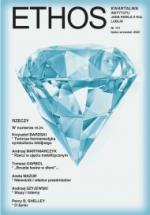 zobacz powiększenie | DOI 10.12887/33-2020-3-131-10 Agnieszka K. HAAS, “All sorts of objects that have fallen out of use, which made them all the more captivating”… (Non-)everyday objects in The Magic Mountain by Thomas Mann Cena brutto: 7,00 PLN za szt. |
|
This article discusses the ways in which Thomas Mann depicts and interprets everyday objects in his novel The Magic Mountain (1924). By combining methods, such as psychoanalysis and material cultural studies approach, and also on the assumption that the polarization of the textual world is inherent in the structure of the novel, it is possible to show the role of things in the construction of the novel. Everyday objects, such as a thermometer, a cigar, a model barometer, a watch, an X-ray image and a photograph, a mechanical Turk, as well as the human body conceived of as a machine, have a double meaning and indicate not only the content hidden in the unconscious of the characters, but also the polarization of the textual world, which is the main construction principle of the novel and alludes to the ancient hermetic knowledge and alchemy. Keywords: Thomas Mann, The Magic Mountain, psychoanalysis, alchemy Contact: Zakład Literatury i Kultury Niemieckiej, Instytut Filologii Germańskiej, Wydział Filologiczny, Uniwersytet Gdański, ul. Wita Stwosza 51, 80-316 Gdańsk, Poland | |
